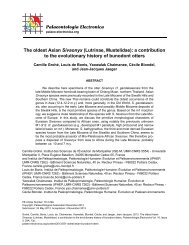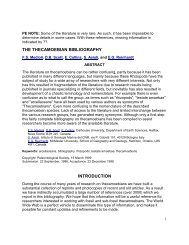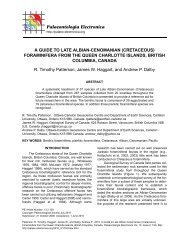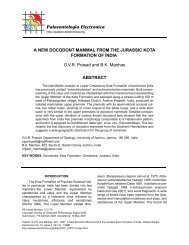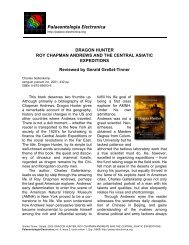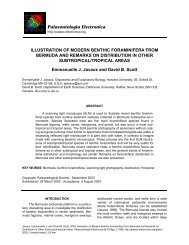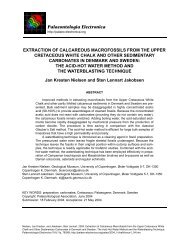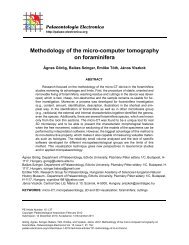Appendicular skeleton and dermal armour of the Late Cretaceous ...
Appendicular skeleton and dermal armour of the Late Cretaceous ...
Appendicular skeleton and dermal armour of the Late Cretaceous ...
Create successful ePaper yourself
Turn your PDF publications into a flip-book with our unique Google optimized e-Paper software.
PALAEO-ELECTRONICA.ORG<br />
FIGURE 5. Hindlimb bones <strong>of</strong> <strong>the</strong> titanosaurian sauropod Lirainosaurus astibiae from <strong>the</strong> <strong>Late</strong> <strong>Cretaceous</strong> <strong>of</strong> Laño<br />
(nor<strong>the</strong>rn Spain). Left femur (MCNA 7468) in 1. anterior, 2. lateral, 3. posterior, 4. proximal (posterior towards top) <strong>and</strong><br />
5. distal (posterior towards top) views. Left tibia (MCNA 13860) in 6. lateral, 7. medial, 8. proximal (medial towards top)<br />
<strong>and</strong> 9. distal (medial towards top) views. Right fibula (MCNA 9410) in 10. lateral, 11. medial, 12. posterior <strong>and</strong> 13. distal<br />
(posterior towards top) views. Abbreviations: aspa, articular surface for <strong>the</strong> ascending process; cc, cnemial crest;<br />
fic, fibular condyle; ft, fourth trochanter; lt, lateral trochanter; tic, tibial condyle; pvp, posteroventral process; ts, trochanteric<br />
shelf.<br />
relative to <strong>the</strong> long axis <strong>of</strong> <strong>the</strong> shaft, especially in<br />
<strong>the</strong> posterior surface. The fibular condyle – which<br />
is unequally divided into a small posterodorsal portion<br />
<strong>and</strong> a larger ventral surface – is anteroposteriorly<br />
more compressed than <strong>the</strong> tibial condyle, <strong>and</strong><br />
<strong>the</strong>y are separated by an intercondylar groove.<br />
Both distal condyles are dorsomedially directed.<br />
The average femoral eccentricity is higher than 2.<br />
Tibia (Figure 5.6-9). The tibiae are slender, have a<br />
mediolaterally compressed diaphysis, <strong>and</strong> <strong>the</strong><br />
proximal articular surface is anteroposteriorly compressed<br />
<strong>and</strong> oval. The cnemial crest is an<br />
exp<strong>and</strong>ed flat rounded ridge. With <strong>the</strong> flat subtriangular<br />
surface <strong>of</strong> <strong>the</strong> distal end treated as <strong>the</strong> anterior<br />
surface, <strong>the</strong> cnemial crest projects<br />
anterolaterally. This cnemial crest delimits a shallow<br />
surface for <strong>the</strong> reception <strong>of</strong> <strong>the</strong> proximal end <strong>of</strong><br />
<strong>the</strong> fibula. In MCNA 2203, a prominent anteromedial<br />
ridge close to <strong>the</strong> distal end delimits two concave<br />
surfaces, one anteriorly located <strong>and</strong> <strong>the</strong> o<strong>the</strong>r<br />
medially directed. In <strong>the</strong> o<strong>the</strong>r specimens <strong>the</strong>se<br />
surfaces <strong>and</strong> <strong>the</strong> ridge are not as conspicuous as<br />
in MCNA 2203. The distal end <strong>of</strong> <strong>the</strong> tibia is more<br />
or less subquadrangular in MCNA 2203 <strong>and</strong> 7471,<br />
but longer anteroposteriorly in MCNA 13860. The<br />
distal posteroventral process is short. The articular<br />
surfaces for <strong>the</strong> ascending process <strong>of</strong> <strong>the</strong> astragalus<br />
<strong>and</strong> for <strong>the</strong> posteroventral process <strong>of</strong> <strong>the</strong> tibiae<br />
<strong>of</strong> L. astibiae are not well pronounced.<br />
Fibula (Figure 5.10-13). The fibula is more slender<br />
than <strong>the</strong> tibia. The cross section <strong>of</strong> <strong>the</strong> diaphysis at<br />
its medial point is more or less subcircular. The<br />
extremities are more exp<strong>and</strong>ed than <strong>the</strong> diaphysis,<br />
especially <strong>the</strong> proximal one. The proximal end is<br />
lateromedially compressed, <strong>the</strong> lateral surface<br />
being convex <strong>and</strong> <strong>the</strong> medial one concave.<br />
Although <strong>the</strong> preservation <strong>of</strong> <strong>the</strong> proximal end <strong>of</strong><br />
most <strong>of</strong> <strong>the</strong> fibulae is not perfectly preserved, in<br />
some specimens – e.g., MCNA 14471 – <strong>the</strong><br />
absence <strong>of</strong> an anteromedial crest, like <strong>the</strong> one<br />
present in <strong>the</strong> fibula <strong>of</strong> <strong>the</strong> basal somphospondylan<br />
sauropod Tastavinsaurus sanzi (Canudo et al.,<br />
9



